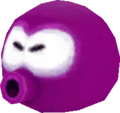Slurple
| Slurple | |||
|---|---|---|---|
 Artwork from Super Mario Galaxy | |||
| First appearance | Super Mario Galaxy (2007) | ||
| Latest appearance | Super Mario Galaxy + Super Mario Galaxy 2 (2025) | ||
| Member of | Octo-Army | ||
| |||
| |||
Slurples[1] are parasitic alien enemies in Super Mario Galaxy and Super Mario Galaxy 2. These enemies have light-blue skin, big eyes, funnel-like mouths, and large, Octoomba-like suction cups on their undersides. Their behavior is similar to that of the Mini Goombas in Super Mario Bros. 3, which are instead treated as full-sized attacking enemies in the games where Slurples appear.
History[edit]
Super Mario Galaxy[edit]
Slurples first appear in Super Mario Galaxy and its Nintendo Switch port, usually appearing in groups of three to five. They at first sit in place, pulsating, but start bouncing at Mario (or Luigi) when he approaches, making a popping noise as they move. If they touch him, the camera zooms in closely on Mario while they will latch on and start slowly draining health from him, like Kamikami. The more Slurples that attach to Mario, the more the camera will zoom on him. In addition to damage, Mario's movement speed is slowed while a Slurple is attached to him. Slurples can be defeated with a spin or a flung Star Bit. If hit with a Star Bit, they will yield three additional Star Bits, while they will yield only one if spun into. They can also be defeated by obstacles such as boulders. Slurples appear primarily in organic galaxies with a large amount of greenery.
There is a visual glitch that can be done with Slurples. If the player is moving Mario while the Slurples are attached to him, defeating all of them with Star Bits will result in him stuck in the pose as if the Slurples were still attached, even while moving around and jumping. Standing still or performing a Star Spin cancels the glitch.
An unused purple variant of Slurple, seen in the game's E3 2006 trailer,[2] is located in the files of Super Mario Galaxy under the name KariKari.[3] Its name resembles Karikari, an enemy from Donkey Kong Jungle Beat, on which the developers previously worked.
Slurples appear in the following list of galaxies and missions. If no mission is stated, Slurples appear during all missions:
- Good Egg Galaxy ("Dino Piranha", "A Snack of Cosmic Proportions", "King Kaliente's Battle Fleet", "Dino Piranha Speed Run")
- Honeyhive Galaxy ("Bee Mario Takes Flight", "Trouble on the Tower", "Big Bad Bugaboom", "The Honeyhive's Purple Coins")
- Gusty Garden Galaxy ("Gusty Garden's Gravity Scramble")
- Gold Leaf Galaxy ("When It Rains, It Pours")
- Sea Slide Galaxy ("The Silver Stars of Sea Slide", "Purple Coins by the Seaside", "Hurry, He's Hungry")
Super Mario Galaxy 2[edit]
In Super Mario Galaxy 2 and its Nintendo Switch port, Slurples act the same as before, but are far less common, only appearing in Puzzle Plank Galaxy's "The Puzzling Picture Block" and Upside Dizzy Galaxy's "A Walk on the Weird Side". Both of these galaxies are themed after wooden blocks, contrasting Slurple's tendency of appearing in natural-themed galaxies in Super Mario Galaxy.
Gallery[edit]
Naming[edit]
Etymology[edit]
The English "Slurple" is a play on "slurp" and, potentially, "supple" or "purple". Though their bodies are blue, there is an unused purple-colored iteration of the enemy called "KariKari" in the E3 2006 trailer,[2] and the name may be in reference to this unused design. The Japanese name,「タコチュ」(Takochu), incorporates「たこ」(tako, "octopus"), indicating they derive from octopuses and are likely members of the Octo-Army.
Internal names[edit]
| Game | File | Name | Meaning
|
|---|---|---|---|
| Super Mario Galaxy Super Mario Galaxy 2 |
ObjectData/Karipon.arc | Karipon | Possibly from「かりかり」(karikari, onomatopoeia for a scraping sound) with「~ぽん」(-pon, a suffix used for cutesy names) |
Names in other languages[edit]
The contemporaneous name for each language is listed first. Subsequent names are listed in chronological order for each language, from oldest to newest, and have the media with which they are associated in the "notes" column. Names exclusive to localizations of the Super Mario Bros. Encyclopedia are not prioritized due to concerns about circular reporting, and are only listed first for their respective languages if they are the only ones available.
| Language | Name | Meaning | Notes |
|---|---|---|---|
| Japanese | タコチュ[4][5][6] Takochu |
From「 |
|
| French | Gluton[7][8] | Play on glu ("glue") and glouton ("glutton") | |
| German | Kussmu[9] | From the surname Kussmaul, itself a portmanteau between Kuss ("kiss") and Maul ("snout") | |
| Blasen-Poink[10] | Bubble Poink; the German name for Poink itself is Oink | Super Mario Bros. Encyclopedia | |
| Italian | Slurpino[11][12] | From "slurp" and the diminutive suffix -ino | |
| Spanish | Octolito[13] | The prefix "octo-", from the English "octopus", with the diminutive suffix -ito |
References[edit]
- ^ Browne, Catherine (2010). Super Mario Galaxy 2: PRIMA Official Game Guide. Roseville: Prima Games. ISBN 978-0-30746-907-6. Page 29.
- ^ a b musico136 (May 10, 2006). Super Mario Galaxy E3 2006 trailer (0:15). YouTube (English).
- ^ TCRF. Super Mario Galaxy/Unused Models § KariKari. The Cutting Room Floor (English). Retrieved February 20, 2020.
- ^ Aoyagi, Masayuki, editor (2007). 『スーパーマリオギャラクシーコンプリートガイド』(Super Mario Galaxy Complete Guide). Tokyo: Enterbrain (Japanese). ISBN 978-4-7577-3943-7. Page 361.
- ^ Tachibana, Tadashi, Isamu Horie, Shinji Kutsuzawa, Itaru Nakatani, Seishiro Fuwa, Kimihara Hongo, and Toshimune Suzuki (2010). 『スーパーマリオギャラクシー2 任天堂ゲーム攻略本』. Tokyo: ambit (Japanese). ISBN 978-4-8399-3630-3. Page 19.
- ^ Sakai, Kazuya (ambit), kikai, Akinori Sao, Junko Fukuda, Kunio Takayama, and Ko Nakahara (Shogakukan), editors (2015). 『スーパーマリオブラザーズ百科: 任天堂公式ガイドブック』. Tokyo: Shogakukan (Japanese). ISBN 978-4-09-106569-8. Page 127, 160.
- ^ Browne, Catherine (2010). Super Mario Galaxy 2 Prima le Guide Officiel. Translated by Yellow Media. Ligugé: Prima Games (French). ISBN 978-2-952-67394-5. Page 31.
- ^ Ardaillon, Joanna, and Victoria Juillard-Huberty, editors (2018). Super Mario Encyclopedia. Translated by Fabien Nabhan. Toulon: Soleil Productions (French). ISBN 978-2-3020-7004-2. Page 127, 160.
- ^ Browne, Catherine (2010). Super Mario Galaxy 2 Das offizielle Lösungsbuch. Translated by Andreas Kasprzak. Lübbecke: Grinning Cat Productions, Prima Games (German). ISBN 402-0-628-08787-6. Page 72.
- ^ Scholz, Sabine, and Benjamin Spinrath, editors (2017). "Super Mario Galaxy" in Super Mario Encyclopedia - Die ersten 30 Jahre : 1985-2015. Translated by Yamada Hirofumi. Hamburg: Tokyopop (German). ISBN 978-3-8420-3653-6. Page 127.
- ^ Browne, Catherine (2010). Super Mario Galaxy 2 Guida Strategica Ufficiale (Multiplayer.it Edizioni). Translated by Christian La Via Colli, Francesca Noto, and Virgina Petrarca. Terni: Multiplayer Edizioni, Prima Games (Italian). ISBN 9788863551198. Page 29.
- ^ Sakai, Kazuya (ambit), kikai, Akinori Sao, Junko Fukuda, Kunio Takayama, Ko Nakahara (Shogakukan), and Marco Figini, editors (2018). Super Mario Bros. Enciclopedia. Translated by Marco Amerighi. Milan: Magazzini Salani (Italian). ISBN 889367436X. Page 126, 160.
- ^ Sakai, Kazuya (ambit), kikai, Akinori Sao, Junko Fukuda, Kunio Takayama, and Ko Nakahara (Shogakukan), editors (2017). "Super Mario Galaxy" in Enciclopedia Super Mario Bros. 30ª Aniversario. Translated by Gemma Tarrés. Barcelona: Editorial Planeta, S.A. (European Spanish). ISBN 978-84-9146-223-1. Page 127.


